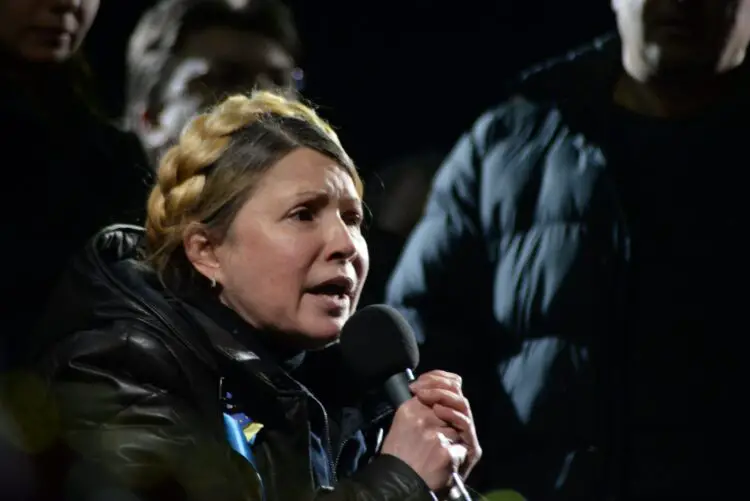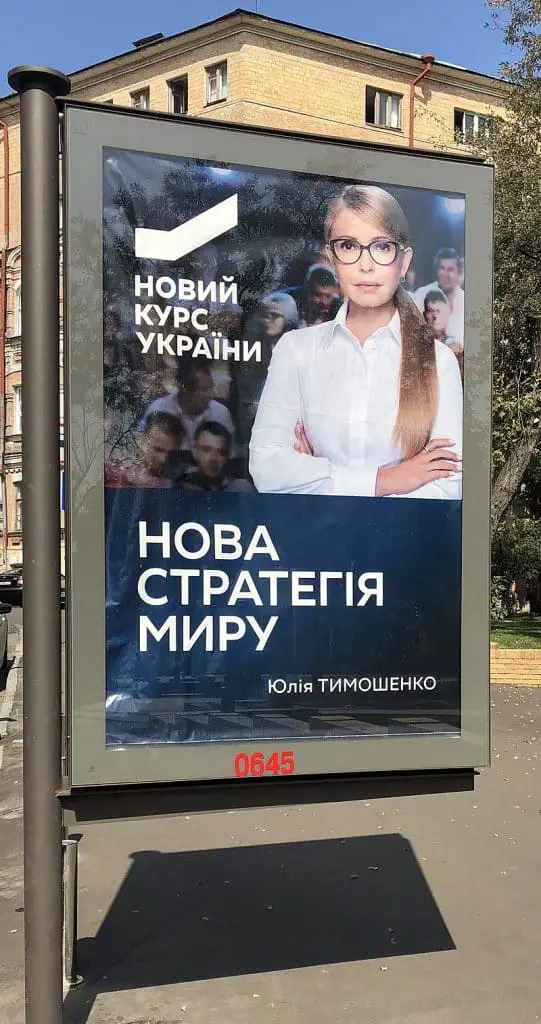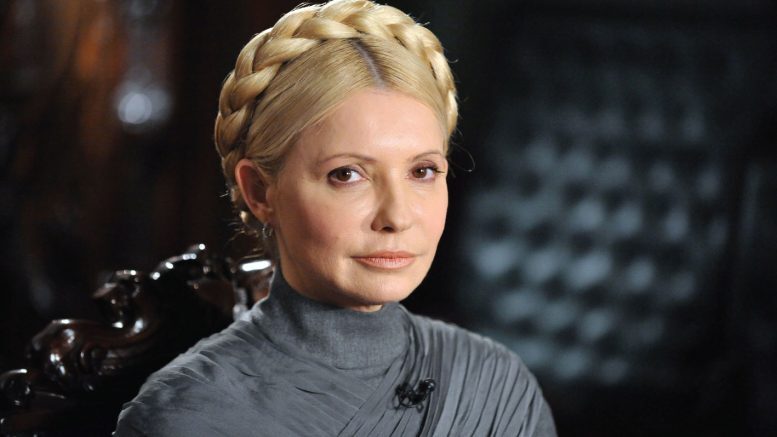A Coalition of Populism and Nationalism
Yulia Tymoshenko is perhaps the most powerful, popular, and controversial woman in Eastern European politics. She rose to power quickly during the turbulent 1990s as a charismatic, sharp-tongued politician able to create wide political coalitions. Her party’s political platform mixes populist social programs, criticisms of capitalism and corruption, and nationalist zeal. Her coalitions, such as the Yulia Tymoshenko Bloc, have likewise mixed both left- and right-wing parties. However, as is often the case in Eastern European politics, the strength of her party and blocs has mostly depended on the strength of her personality and personal involvement.
Two short political platforms for her party are available from Geohistory here.
Early Life and Career
Yulia Tymoshenko was born in Dnipropetrosk in Eastern Ukraine and was raised by a single mother for most of her life. After graduating from the Dnipropetrovsk State University in 1984, she worked for the administration of a machine building plant and married a mid-level Soviet bureaucrat, Oleksandr Tymoshenko. Under perestroika, Tymoshenko and her family helped found many businesses, including United Energy Systems of Ukraine, once the country’s largest natural gas importer.
Tymoshenko first entered politics in December, 1996 when she was elected to the Verkhovna Rada as an independent. In 1997, she joined Hromada, then a new social democratic party. In the 1998 parliamentary elections, Hromada’s first time on the ballot, it won 4.7% of the national vote, with strong support in the Tymoshenko’s native Dnipropetrovsk region.
Tymoshenko was selected by Hromada to chair the Rada’s large and powerful budget committee. At the time, Ukraine was steadily climbing out of a deep recession. Just three years prior, in 1995, Ukraine’s GDP had fallen 23%. By 1999, the fall had been stabilized, but the damage was deep. During her chairmanship, Tymoshenko worked on budget, tax, pension, and medical insurance reform. In one of her most popular early achievments, pension and state salary debts, which had accumulated during the economic chaos that had followed the collapse of the Soviet Union, were paid in full.
In early 1999, Hromada founder Pavlo Lazarenko, accused of embezzlement, fled the country. Tymoshenko and others abandoned the party to distance themselves from the scandal. Tymoshenko quickly set up her own left-leaning party and faction, the Fatherland All-Ukrainian Union, also known as Batkivshchyna, in July of 1999.

Former Prime Minister of Ukraine Yulia Tymoshenko on a motorcycle. Her trademark braids are a traditional Ukrainian style that she is almost never seen without.
Batkivshchyna initially supported President Kuchma’s center-right administration, despite Batkivshchyna’s leftist ideology and Kuchma’s controversies: some credited him with saving Ukraine from the worst of the economic disaster; others accused him of causing it by allowing corruption to flourish. On December 30, 1999, Tymoshenko was appointed Vice Prime Minister of Fuel and Energy in Prime Minister Viktor Yushchenko’s cabinet under Kuchma. Tymoshenko focused on anti-corruption measures during her tenure.
In January 2001, herself accused of corruption, Tymoshenko was dismissed as Minister. In February 2001, Tymoshenko was arrested on charges of tax evasion and smuggling gas from Russia while acting as president of United Energy Systems of Ukraine. Tymoshenko and her supporters argue the allegations were fabricated by Kuchma and oligarchs whose interests were damaged by Tymoshenko’s anti-corruption programs.
After 24 days of pre-trial detention, the charges were dropped and Tymoshenko was released. Batkivshchyna immediately joined the growing Ukraine without Kuchma movement, seeking the president’s resignation.
Tymoshenko then founded the Yulia Tymoshenko Bloc with left- and right-leaning parties: Batkivshchyna, Sobor, the Ukrainian Social Democratic Party, and the Ukrainian Republican Party. The bloc gained twenty-two Rada seats in the 2002 elections. Thirteen went to Batkivsychyna members.
Orange Revolution and Aftermath
In late 2002, Batkivsychyna allied with Viktor Yushchenko’s center-right party, Our Ukraine, as well as with the Communists and Socialists, to defeat President Kuchma’s supported candidate, Viktor Yanukovych, in the 2004 presidential election. As part of the coalition, Yushchenko promised to nominate Tymoshenko for Prime Minister should he win. Kuchma himself was excluded from running by constitutional term limits.
In the first round of voting, Yushchenko and Yanukovych came in first and second place respectively. Most analysts and exit polls named Yushchenko the winner of the second round. However, official results gave a +3% victory to Yanukovych. Alleging mass fraud, Yushchenko called for protests. Tymoshenko became a key figure in what became known as “The Orange Revolution,” giving speeches that attracted hundreds of thousands of protestors and international support from the US and EU. Ultimately, new elections were called and Yushchenko was elected with a nearly +8% lead.
Video released by Yulia Tymoshenko shortly before she was arrested on charges of corruption. Spoken in Ukrainian with English subtitles.
Tymoshenko was confirmed as Prime Minister with the overwhelming support of 83% of Rada deputies. However, as is also often the case in politics in Eastern European countries, while diverse parities are often able to unite against a common enemy, they are often not able to agree on a common plan to govern. The ideological differences within the Orange Coalition soon fractured it. Yushchenko dismissed Tymoshenko from her position just months into her term.
In 2006, both Sobor and the Ukrainian Republican Party left Tymoshenko’s bloc to unite into a single party. However, power struggles in that movement led to fracturing as well and the majority of those right-wing politicians migrated back to the coalition in some form. The bloc later came second in the 2006 elections, winning 22.27% of the vote and earning 129 seats in parliament – increasing their parliamentary representation by nearly 500%.
By 2006, Tymoshenko, Batkivsychyna, and their platforms were known and appealing to many Ukrainians. Lower taxes, better pensions, a higher minimum wage, and anti-corruption programs were just a few of their populist planks. Batkivsychyna was oriented more towards Europe, and less towards Russia. They were opposed in this by Yanukovych’s Party of Regions, their main revials. Batkivsychyna also appealed to nationalists, promising to protect and support Ukrainian culture and language. They opposed establishing Russian (spoken by nearly 20% of Ukrainians) as a second state language; they argued that enough Russians living in Ukraine understood Ukrainian and that Ukrainian needed special protection after decades of Soviet repression.
Tymoshenko and her party were also helped in the election by the fact that Yushchenko, as president, bore most of the public blame for the political infighting and gridlock that followed the Orange Revolution. Yushchenko’s bloc lost nearly 30% of their seats in that election. The Ukrainian political field also saw some consolidation, in part due to constitutional reforms in 2005, championed in part by Tymoshenko, which eliminated single-mandate districts and added seats to the Rada.
Even with such gains, Tymoshenko’s party could not defeat Yanukovych’s Party of Regions, which also gained votes and retained the Rada’s largest faction – despite the recent accusations of electoral fraud. After months of political crisis, President Yushchenko called for new parliamentary elections in 2007. Tymoshenko gained another 1.5 million votes and 27 Rada seats that year. Uniting again with Yushchenko, Tymoshenko formed “Yushchenko’s Bloc,” forced Yanukovych from the post of Prime Minister and was elected there in his place.
Effects of the 2008 Global Crisis
A year later, the global financial crisis hit. Ukraine’s currency, the hyrvnia, depreciated nearly 40% between 2007 and 2010, making imported products more expensive in a land whose own industry was largely dependent on aging Soviet infrastructure. Inflation doubled between 2007 and 2008; GDP declined 15% between 2008 and 2009.
Tymoshenko’s government responded with populist economic stimulus. For example, to compensate citizens who had held funds in the former Soviet Savings Bank, which collapsed with the USSR, Tymoshenko’s government paid out one thousand hryvnias each to 6.5 million depositors. Many blame Ukraine’s then-unparalleled inflation on Tymoshenko’s massive spending. Tymoshenko’s detractors also blamed her for failing to agree on purchase terms in 2008 for the Russian natural gas upon which industry and residential heating in Ukraine is largely dependent. In the “gas war” that followed, in one day in late December 2008, gas prices skyrocketed by 35%, straining the weakened economy even further.
Yulia Tymoshenko and Vladimir Putin describe the gas deal that will eventually land Tymoshekno in jail.
Tymoshenko also supported constitutional amendments transferring more governing power from the president to parliament. Although Yushchenko had supported similar amendments in 2005, he now protested the new amendments as a personal attack on himself. Tymoshenko voted with the rival Communist Party and Party of Regions to pass them. Yushchenko pulled out of the coalition, which served only to strengthen Yanukovych’s position and weaken Yushchenko’s.
In June 2009, Tymoshenko announced her candidacy for the 2010 presidential election and was backed by her bloc. Tymoshenko and Yanukovych were front-runners from the beginning and fought vicious campaigns: Yanukovych stressed the economic failings of Tymoshenko’s government, while Tymoshenko tried to discredit Yanukovych as a corrupt political insider.

Results of the second round of voting in the 2010 Ukrainian presidential election. Provinces voting heavily for Yanukovytch are darker blue; those voting more heavily for Tymoshenko are darker red. The country has long been split politically between the more Russian and conservative East and the more Ukrainian, European West. Graphic from Wikipedia.
In the second round voting, Yanukovych won with 48.95% of the vote to Tymoshenko’s 45.4%. Shortly after, the Verkhovna Rada, still dominated by Yanukovych’s party, dissolved Tymoshenko’s government. Tymoshenko and her bloc once again entered the opposition.
Tymoshenko’s Imprisonment
Following on accusations made by Yanukovych, the prosecutor general’s office charged Tymoshenko in June 2011, with abuse of office in her handling of a natural gas contract signed with Russia in 2009. In October, she was sentenced to seven years in prison. Her supporters accused Yanukovych of fabricating the charges to silence his only significant political rival.
In 2011, the Rada banned blocs from participating in parliamentary elections, removing from Tymoshenko one of her favored political maneuvers. In the 2012 elections, with their leader in prison and coalition non-functioning, Batkivshchyna lost nearly two million votes and about a third of their Rada representation. Tymoshenko held multiple hunger strikes to protest alleged vote rigging.
In an attempt to recover, Tymoshenko began to position Batkivshchyna as an “umbrella party,” absorbing the smaller parties that once supported he bloc. In June of 2013, the party nominated Tymoshenko, still in prison at the time, as their candidate for president in the 2015 elections, well ahead of any other party nominations.
Despite international pressure from the EU and US, Yanukovych was not willing to compromise on Tymoshenko’s conviction. In late 2013, Tymoshenko requested to be sent to Germany for treatment for a herniated disc. This was denied, as it was feared that she would likely seek asylum while there.
Yulia Tymoshenko’s daughter Yevhenia gives an interview to RFERL about her mother’s condition. Yevhenia Tymoshenko has been leading an international effort to free her mother since 2011.
2014 Euromaidan Revolution and Aftermath
In the midst of the 2014 Euromaidan Revolution, the Verkhovna Rada, in a 310-54 veto-exempt vote, voted to decriminalize the article under which Tymoshenko had been convicted. She was exonerated and released.
On 22 February, the same day that Yanukovych fled Ukraine for Russia, Tymoshenko left the hospital in Kharkiv, where she had been receiving medical attention since May 2012 while still serving her jail sentence. The same day, Tymoshenko travelled back to Kyiv and addressed the protestors on the Maidan, praising their actions and saying that the protests must continue to complete the process of “bringing down a dictatorship.”
On 28 February, the Verkhovna Rada rehabilitated Tymoshenko and restored all of her pre-arrest rights, including the ability to run for office.
Despite still recovering physically, Tymoshenko flew into a flurry of political activity to solidify gains from the Maidan revolution – and address a new ever-growing crisis as conflicts in Crimea and then the Donbass region grew as Russia supported regions that had been Yanukovych’s main political base and which opposed the revolution.
Tymoshenko held multiple meetings and phone conversations with officials from the United States, the European Union, and the OSCE. She called on these nations and organizations to uphold Budapest Memorandum, which guarantees Ukraine’s territorial integrity, and to help stop, what she called “Russian aggression” in Eastern and Southern Ukraine. In early March, Tymoshenko attended the European People’s Party political conference in Dublin where she garnered support from western leaders such as Angela Merkel, Michel Barnier, Donald Tusk, and more.
All this time, Tymoshenko was working to strengthen her political position domestically as well. In March, she refused the prime ministership and instead declared that she would run for president in 2014. Batkivshchyna nominated her two days later and registered her as an official candidate.
Tymoshenko received 12.81% of the vote, enough to come in second in a field of five candidates, but not enough win against Petro Poroshenko, who won 55% in the first round.
Multiple issues worked against Tymoshenko. First, she spent time out of the country seeking medical treatment in Germany. Second, multiple parties ran on similar programs – focusing on corruption, living standards, the Donbass Conflict. Third, Tymoshenko alienated many voters when, first, a tape of her purportedly saying that ethnic Russians “exiled” in Ukraine should be “nuked” and, second, by insisting that Ukraine should join NATO, a policy move then opposed by nearly as many Ukrainians as those who supported it.
Perhaps most importantly, however, was the fact that Tymoshenko had been largely absent from the day to day operations of her political party for years. The party had not recovered from previous parliamentary election defeats and the new umbrella party had never fully consolidated its new members. Soon after the election, Arseniy Yatsenyuk, who had taken over party leadership in Tymoshenko’s absence, left with his supporters and formed a new party that opposed Batkivshchyna in the 2014 parliamentary elections. Tymoshenko’s party won just 19 seats, losing four-fifths of its representation.
A brief explanation of how Poroshenko consolidated power with the People’s Front party can be found on Geohistory here.

Tymoshenko addressing the protestors on the Maidan after her release from prison.
Upcoming 2019 Presidential Election
Today, several things have changed in Tymoshenko’s favor. First, Poroshenko has lost most of his support as nearly none of this campaign promises of improving living standards, quickly ending the war, and curbing corruption have come to fruition. Further, while still divisive, support for associations with the EU and NATO have been gaining support with Ukrainians. Tymoshenko has argued that Ukraine is “in a void, outside all existing security systems” and the only way to ensure Ukraine’s sustained safety is to create a free trade relationship with the EU that will eventually become EU membership. In late 2018, she claimed emphatically that “Ukraine will be in the EU and in NATO.”
She has worked to walk back her past association with the idea of “nuking” Russians. Her primary sentiment expressed now is that Ukrainians must love each other; “love one another, from Donetsk, Crimea, Luhansk, Dnipropetrovsk, Kharkiv, Lviv, Ternopil, Ivan-Frankivsk, Kyiv, and all other corners of our native land.”
Tymoshenko has also taken a strong position on the Donbas Conflict. She has argued that the Minsk ceasefire agreements have failed because negotiations with the separatist leaders are useless, referring to them as “absolute marionettes.” In November of 2018, Tymoshenko stated that she believes that the “path to peace” is in strengthening the military, increasing ties with the EU, and directly addressing the Russian Federation in peace negotiations for Eastern Ukraine.
Tymoshenko has remained the main voice of opposition to President Poroshenko and his running against him in the 2019 presidential election. Although her approval ratings are low and disapproval ratings high, all candidates suffer from this challenge. As of early December 2018, polls forcast Tymoshenko and Batkivshchyna to win 14% of the vote while Poroshenko will receive only 8%, which would place him near three other candidates who are also poling at 8-6%. Thus, the main question is who will oppose Tymoshenko in round two of the elections.

A 2019 campaign poster for Tymoshenko. The sign translates: “The New Course of Ukraine. A New Strategy for Peace.”
Tymoshenko and Poroshenko are running campaigns that focus on popular rumors surrounding their opponent: Tymoshenko is running against Poroshenko’s alleged corrupt oligarchy while Poroshenko is running against Tymoshenko’s alleged willingness to compromise with Russia at the expense of Ukrainian sovereignty. Ukrainian voters are currently split between Tymoshenko, a handful of other candidates, and simply not voting. However, the result of the election is important as Poroshenko and Tymoshenko are offering two very different ways forward for Ukraine in relation to the global flashpoint between Russia and Ukraine.
Geohistory offers two short platforms for Batkivshchyna here. Both are remarkably short. The first is from the party’s wildly successful 2006 parliamentary campaign. The second, more terse and defiant, is from the 2012 elections. Both have been translated by Home and Abroad Scholars at the School of Russian and Asian Studies from Russian translations of the Ukrainian original texts.



